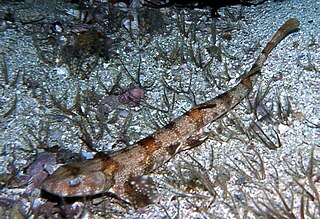 W
WThe estuarine pipefish or river pipefish is a species of fish in the family Syngnathidae. It is endemic to South Africa and has been sporadically recorded in the estuarine portions of the Kariega, Kasouga, Bushmans, East Kleinemonde and West Kleinemonde Rivers. It can be readily distinguished from another southern African pipefish with which it shares its habitat, S. temminckii, by its much shorter snout. The estuarine pipefish is most commonly found in beds of the eelgrass Zostera capensis. Although twice thought to be extinct, recent surveys have found juvenile Estuarine Pipefish in areas where it had not been reported in over four decades.
 W
WThe Eastern Cape redfin is an African freshwater fish species in the family Cyprinidae., this appears to be a species complex rather than a single species.
 W
WThe smallscale redfin is a freshwater fish in the family Cyprinidae which is endemic to South Africa. It is threatened by habitat destruction and the impact of invasive species.
 W
WThe Verlorenvlei redfin is a species of barb endemic to the Verlorenvlei River in South Africa.
 W
WThe brown shyshark or plain happy is a species of catshark, part of the family Scyliorhinidae. It is endemic to the shallow, coastal waters of South Africa from west of Cape Agulhas to KwaZulu-Natal. This benthic species is usually found over sandy or rocky bottoms. Measuring up to 73 cm (29 in) long, the brown shyshark is stoutly built, with a broad, flattened head and rounded snout. Unlike other shysharks, the brown shyshark has a plain brown color, though some individuals have faint "saddle" markings or light or dark spots. When threatened, this shark curls into a circle with its tail over its eyes, which is the origin of the name "shyshark". It feeds on bony fishes and lobsters, and is oviparous with females laying pairs of egg capsules. The International Union for Conservation of Nature (IUCN) has assessed this harmless species as Vulnerable. It is of no commercial or recreational interest, but its limited distribution makes its entire population vulnerable to increases in fishing pressure or habitat degradation.
 W
WThe Natal shyshark, eastern shyshark or happy chappie is a species of catshark, belonging to the family Scyliorhinidae. It was once regarded as the "Natal" form of the puffadder shyshark. This shark is endemic to a small area off South Africa from the Western Cape to KwaZulu-Natal. It is found close to the coast, from the surf zone to a depth of 30 m (98 ft), and has benthic habits. Reaching 50 cm (20 in) in length, the Natal shyshark is similar to the puffadder shyshark in appearance but has a stockier body, less flattened head, a compressed caudal peduncle, and a different color pattern. Rare and under threat from habitat degradation and commercial fishing, it has been assessed as Vulnerable by the International Union for Conservation of Nature (IUCN).
 W
WThe puffadder shyshark is a species of catshark, belonging to the family Scyliorhinidae, endemic to the temperate waters off the coast of South Africa. This common shark is found on or near the bottom in sandy or rocky habitats, from the intertidal zone to a depth of 130 m (430 ft). Typically reaching 60 cm (24 in) in length, the puffadder shyshark has a slender, flattened body and head. It is strikingly patterned with a series of dark-edged, bright orange "saddles" and numerous small white spots over its back. The Natal shyshark, formally described in 2006, was once considered to be an alternate form of the puffadder shyshark.
 W
WThe white steenbras is a species of fish in the family Sparidae endemic to South Africa. Due to overfishing, primarily by seine netting operations in False Bay, the white steenbras is now critically endangered and is about to become a 'no keep' species in South Africa. Massive breeding shoals are illegally wiped out by beach seine netters each year, with the authorities doing little to prevent this. The species was identified as a priority for research, management and conservation in a National Linefish Status Report